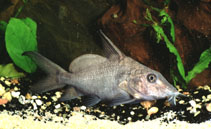| Family: |
Mochokidae (Squeakers or upside-down catfishes), subfamily: Mochokinae |
| Max. size: |
46 cm SL (male/unsexed) |
| Environment: |
benthopelagic; freshwater; pH range: 6.80000019073486 - 7.19999980926514; dH range: 25, potamodromous |
| Distribution: |
Africa: Nile basin (Ref. 3202, 28714), Senegal, Gambia, Volta, Niger (including Benue) and Chad (Ref. 7362, 57223). |
| Diagnosis: |
Dorsal spines (total): 1; Anal spines: -0. Diagnosis: gill slits extending downwards beyond pelvic-fin insertions to the midline of isthmus; maxillary barbels not longer than head, lacking tubercles and ramifications, but with a broad, black membrane extending over their entire length; mandibular barbels with a broad black membrane; outer and inner mandibular barbels with few and simple ramifications, and membranous at tips; mandibular teeth short, numbering 8-16; pectoral-fin spines more strongly denticulate on inner than on outer margin; dorsal-fin spine smooth, except for weak serrations present on posterior margin in some specimens; humeral process deep, short, granular and not keeled ventrally; adipose fin high, long and contiguous to rayed dorsal fin (Ref. 57223).
Coloration: typically inverted colour, the back being uniformly whitish-grey and the belly black; fins greyish, without spots; maxillary and mandibular barbels (particularly the outer pair) bordered by a broad, black membrane (Ref. 57223). |
| Biology: |
Occurs in deep water close to the shore. Omnivore, feeds on plankton and detritus (Ref. 13868). May also feed on surface insects, chironomid larvae, benthic crustaceans, and mollusks (Ref. 28714). Oviparous (Ref. 205). Maximum size reported as 50.0cm (length type not given)(Ref. 31256). |
| IUCN Red List Status: |
Least Concern (LC); Date assessed: 15 April 2020 Ref. (130435)
|
| Threat to humans: |
harmless |
| Country info: |
|
Source and more info: www.fishbase.org. For personal, classroom, and other internal use only. Not for publication.

